Strategic HRM: Challenges, Future Trends, and Organizational Impact
VerifiedAdded on 2019/12/03
|9
|2827
|174
Report
AI Summary
This report provides a comprehensive overview of Strategic Human Resource Management (SHRM), emphasizing its critical role in modern organizations. It defines HRM as encompassing recruitment, development, maintenance, and motivation of human resources. The report outlines key functions such as planning, organizing, directing, and controlling personnel. It also details operative activities including recruitment, selection, training, and compensation. The report further discusses the challenges faced by HR professionals, including global expansion, employee mobility, human relations management, legal and political environments, and the increasing ambition of employees. It highlights the shift towards strategic and integrated HRM, emphasizing the importance of facilitating change, mediating between employees and the organization, and incorporating talent, reward, and performance management. The report concludes by underscoring the significance of effective HRM in achieving organizational goals and adapting to environmental factors.
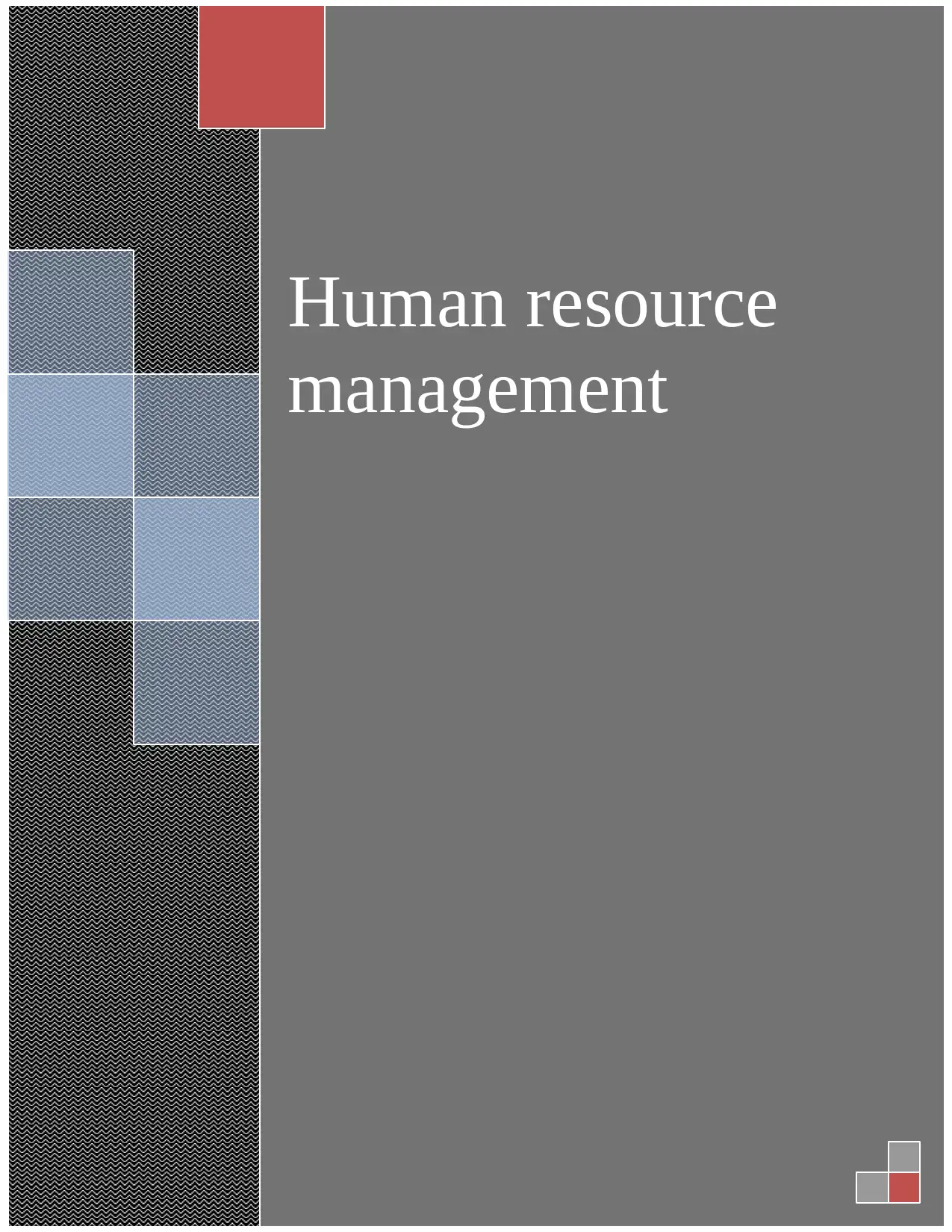
Human resource
management
management
Paraphrase This Document
Need a fresh take? Get an instant paraphrase of this document with our AI Paraphraser
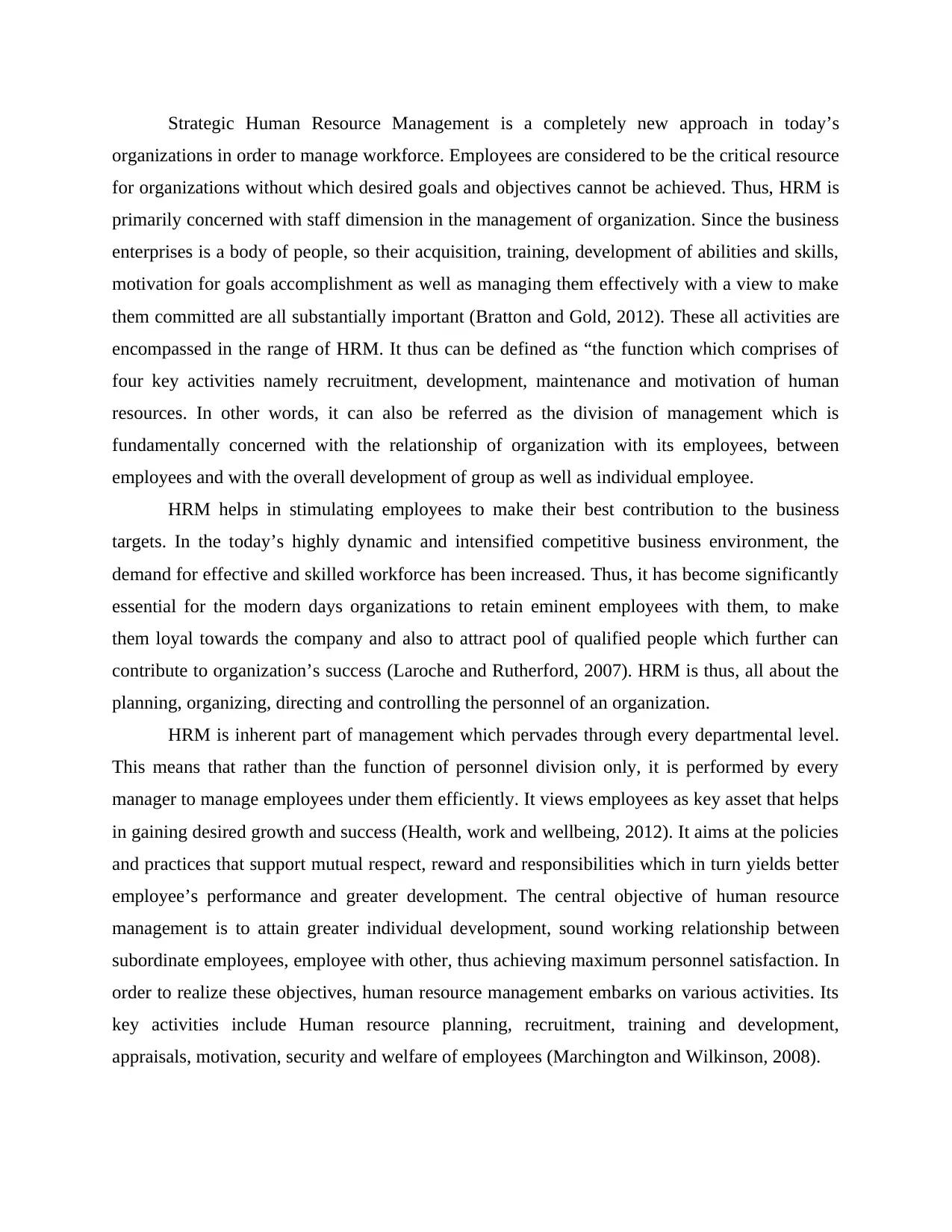
Strategic Human Resource Management is a completely new approach in today’s
organizations in order to manage workforce. Employees are considered to be the critical resource
for organizations without which desired goals and objectives cannot be achieved. Thus, HRM is
primarily concerned with staff dimension in the management of organization. Since the business
enterprises is a body of people, so their acquisition, training, development of abilities and skills,
motivation for goals accomplishment as well as managing them effectively with a view to make
them committed are all substantially important (Bratton and Gold, 2012). These all activities are
encompassed in the range of HRM. It thus can be defined as “the function which comprises of
four key activities namely recruitment, development, maintenance and motivation of human
resources. In other words, it can also be referred as the division of management which is
fundamentally concerned with the relationship of organization with its employees, between
employees and with the overall development of group as well as individual employee.
HRM helps in stimulating employees to make their best contribution to the business
targets. In the today’s highly dynamic and intensified competitive business environment, the
demand for effective and skilled workforce has been increased. Thus, it has become significantly
essential for the modern days organizations to retain eminent employees with them, to make
them loyal towards the company and also to attract pool of qualified people which further can
contribute to organization’s success (Laroche and Rutherford, 2007). HRM is thus, all about the
planning, organizing, directing and controlling the personnel of an organization.
HRM is inherent part of management which pervades through every departmental level.
This means that rather than the function of personnel division only, it is performed by every
manager to manage employees under them efficiently. It views employees as key asset that helps
in gaining desired growth and success (Health, work and wellbeing, 2012). It aims at the policies
and practices that support mutual respect, reward and responsibilities which in turn yields better
employee’s performance and greater development. The central objective of human resource
management is to attain greater individual development, sound working relationship between
subordinate employees, employee with other, thus achieving maximum personnel satisfaction. In
order to realize these objectives, human resource management embarks on various activities. Its
key activities include Human resource planning, recruitment, training and development,
appraisals, motivation, security and welfare of employees (Marchington and Wilkinson, 2008).
organizations in order to manage workforce. Employees are considered to be the critical resource
for organizations without which desired goals and objectives cannot be achieved. Thus, HRM is
primarily concerned with staff dimension in the management of organization. Since the business
enterprises is a body of people, so their acquisition, training, development of abilities and skills,
motivation for goals accomplishment as well as managing them effectively with a view to make
them committed are all substantially important (Bratton and Gold, 2012). These all activities are
encompassed in the range of HRM. It thus can be defined as “the function which comprises of
four key activities namely recruitment, development, maintenance and motivation of human
resources. In other words, it can also be referred as the division of management which is
fundamentally concerned with the relationship of organization with its employees, between
employees and with the overall development of group as well as individual employee.
HRM helps in stimulating employees to make their best contribution to the business
targets. In the today’s highly dynamic and intensified competitive business environment, the
demand for effective and skilled workforce has been increased. Thus, it has become significantly
essential for the modern days organizations to retain eminent employees with them, to make
them loyal towards the company and also to attract pool of qualified people which further can
contribute to organization’s success (Laroche and Rutherford, 2007). HRM is thus, all about the
planning, organizing, directing and controlling the personnel of an organization.
HRM is inherent part of management which pervades through every departmental level.
This means that rather than the function of personnel division only, it is performed by every
manager to manage employees under them efficiently. It views employees as key asset that helps
in gaining desired growth and success (Health, work and wellbeing, 2012). It aims at the policies
and practices that support mutual respect, reward and responsibilities which in turn yields better
employee’s performance and greater development. The central objective of human resource
management is to attain greater individual development, sound working relationship between
subordinate employees, employee with other, thus achieving maximum personnel satisfaction. In
order to realize these objectives, human resource management embarks on various activities. Its
key activities include Human resource planning, recruitment, training and development,
appraisals, motivation, security and welfare of employees (Marchington and Wilkinson, 2008).
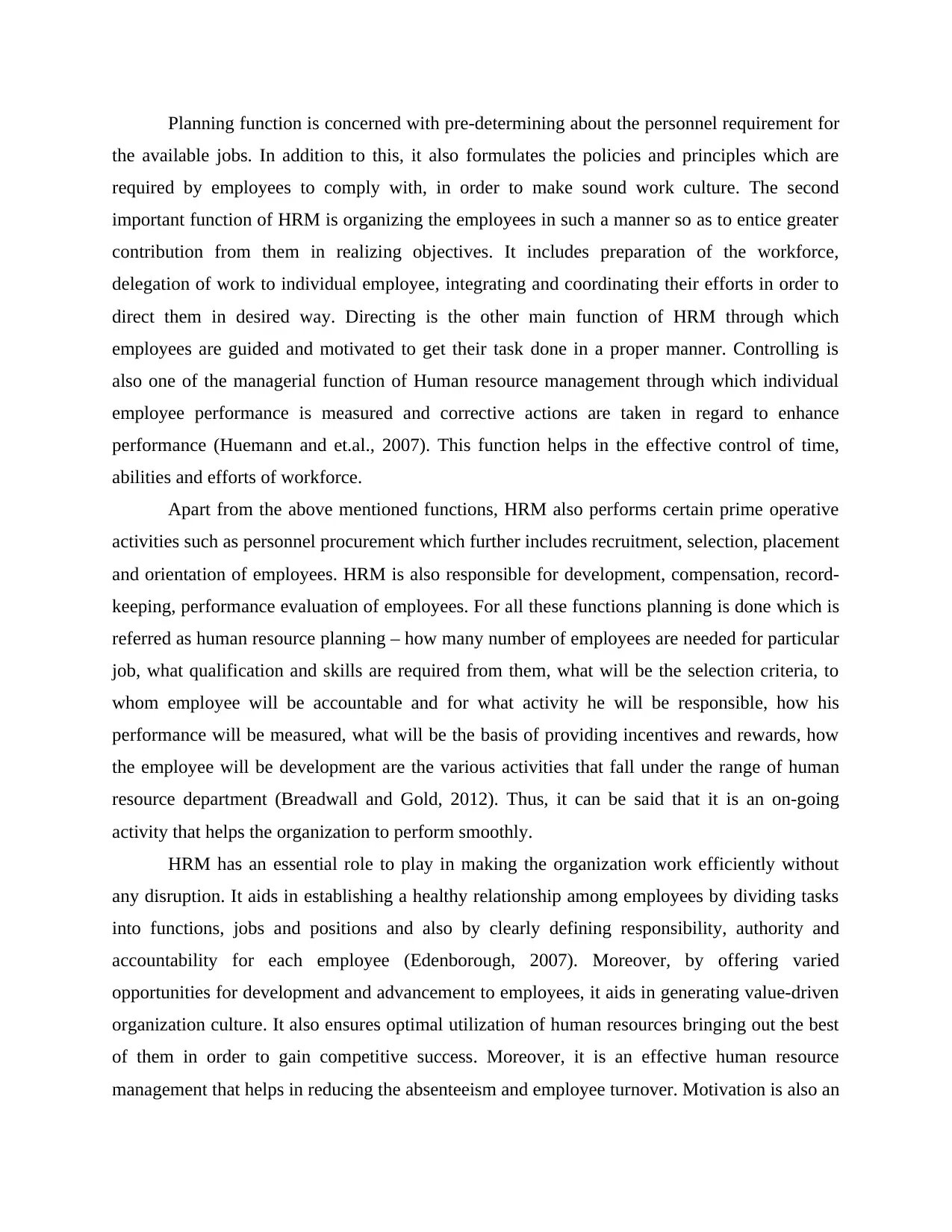
Planning function is concerned with pre-determining about the personnel requirement for
the available jobs. In addition to this, it also formulates the policies and principles which are
required by employees to comply with, in order to make sound work culture. The second
important function of HRM is organizing the employees in such a manner so as to entice greater
contribution from them in realizing objectives. It includes preparation of the workforce,
delegation of work to individual employee, integrating and coordinating their efforts in order to
direct them in desired way. Directing is the other main function of HRM through which
employees are guided and motivated to get their task done in a proper manner. Controlling is
also one of the managerial function of Human resource management through which individual
employee performance is measured and corrective actions are taken in regard to enhance
performance (Huemann and et.al., 2007). This function helps in the effective control of time,
abilities and efforts of workforce.
Apart from the above mentioned functions, HRM also performs certain prime operative
activities such as personnel procurement which further includes recruitment, selection, placement
and orientation of employees. HRM is also responsible for development, compensation, record-
keeping, performance evaluation of employees. For all these functions planning is done which is
referred as human resource planning – how many number of employees are needed for particular
job, what qualification and skills are required from them, what will be the selection criteria, to
whom employee will be accountable and for what activity he will be responsible, how his
performance will be measured, what will be the basis of providing incentives and rewards, how
the employee will be development are the various activities that fall under the range of human
resource department (Breadwall and Gold, 2012). Thus, it can be said that it is an on-going
activity that helps the organization to perform smoothly.
HRM has an essential role to play in making the organization work efficiently without
any disruption. It aids in establishing a healthy relationship among employees by dividing tasks
into functions, jobs and positions and also by clearly defining responsibility, authority and
accountability for each employee (Edenborough, 2007). Moreover, by offering varied
opportunities for development and advancement to employees, it aids in generating value-driven
organization culture. It also ensures optimal utilization of human resources bringing out the best
of them in order to gain competitive success. Moreover, it is an effective human resource
management that helps in reducing the absenteeism and employee turnover. Motivation is also an
the available jobs. In addition to this, it also formulates the policies and principles which are
required by employees to comply with, in order to make sound work culture. The second
important function of HRM is organizing the employees in such a manner so as to entice greater
contribution from them in realizing objectives. It includes preparation of the workforce,
delegation of work to individual employee, integrating and coordinating their efforts in order to
direct them in desired way. Directing is the other main function of HRM through which
employees are guided and motivated to get their task done in a proper manner. Controlling is
also one of the managerial function of Human resource management through which individual
employee performance is measured and corrective actions are taken in regard to enhance
performance (Huemann and et.al., 2007). This function helps in the effective control of time,
abilities and efforts of workforce.
Apart from the above mentioned functions, HRM also performs certain prime operative
activities such as personnel procurement which further includes recruitment, selection, placement
and orientation of employees. HRM is also responsible for development, compensation, record-
keeping, performance evaluation of employees. For all these functions planning is done which is
referred as human resource planning – how many number of employees are needed for particular
job, what qualification and skills are required from them, what will be the selection criteria, to
whom employee will be accountable and for what activity he will be responsible, how his
performance will be measured, what will be the basis of providing incentives and rewards, how
the employee will be development are the various activities that fall under the range of human
resource department (Breadwall and Gold, 2012). Thus, it can be said that it is an on-going
activity that helps the organization to perform smoothly.
HRM has an essential role to play in making the organization work efficiently without
any disruption. It aids in establishing a healthy relationship among employees by dividing tasks
into functions, jobs and positions and also by clearly defining responsibility, authority and
accountability for each employee (Edenborough, 2007). Moreover, by offering varied
opportunities for development and advancement to employees, it aids in generating value-driven
organization culture. It also ensures optimal utilization of human resources bringing out the best
of them in order to gain competitive success. Moreover, it is an effective human resource
management that helps in reducing the absenteeism and employee turnover. Motivation is also an
⊘ This is a preview!⊘
Do you want full access?
Subscribe today to unlock all pages.

Trusted by 1+ million students worldwide
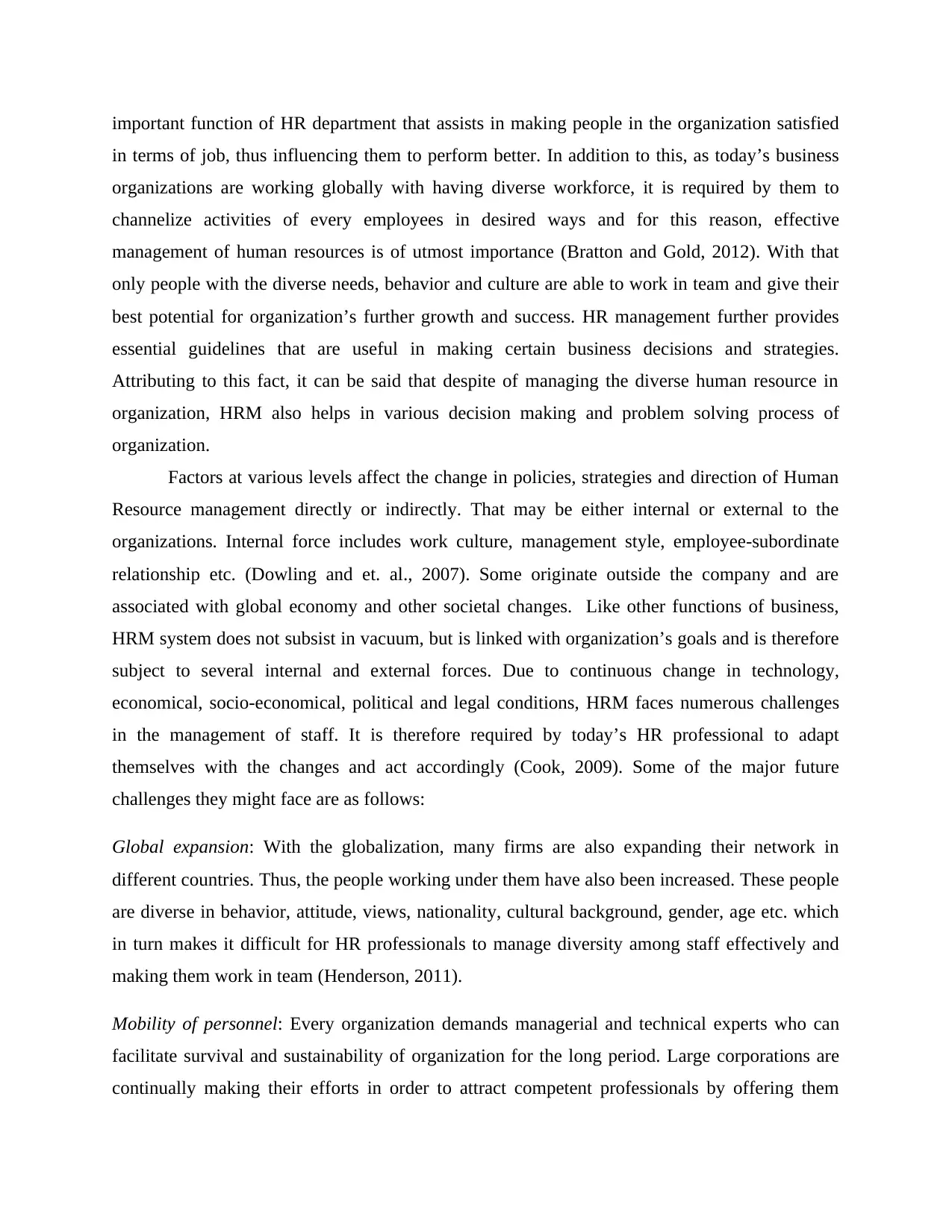
important function of HR department that assists in making people in the organization satisfied
in terms of job, thus influencing them to perform better. In addition to this, as today’s business
organizations are working globally with having diverse workforce, it is required by them to
channelize activities of every employees in desired ways and for this reason, effective
management of human resources is of utmost importance (Bratton and Gold, 2012). With that
only people with the diverse needs, behavior and culture are able to work in team and give their
best potential for organization’s further growth and success. HR management further provides
essential guidelines that are useful in making certain business decisions and strategies.
Attributing to this fact, it can be said that despite of managing the diverse human resource in
organization, HRM also helps in various decision making and problem solving process of
organization.
Factors at various levels affect the change in policies, strategies and direction of Human
Resource management directly or indirectly. That may be either internal or external to the
organizations. Internal force includes work culture, management style, employee-subordinate
relationship etc. (Dowling and et. al., 2007). Some originate outside the company and are
associated with global economy and other societal changes. Like other functions of business,
HRM system does not subsist in vacuum, but is linked with organization’s goals and is therefore
subject to several internal and external forces. Due to continuous change in technology,
economical, socio-economical, political and legal conditions, HRM faces numerous challenges
in the management of staff. It is therefore required by today’s HR professional to adapt
themselves with the changes and act accordingly (Cook, 2009). Some of the major future
challenges they might face are as follows:
Global expansion: With the globalization, many firms are also expanding their network in
different countries. Thus, the people working under them have also been increased. These people
are diverse in behavior, attitude, views, nationality, cultural background, gender, age etc. which
in turn makes it difficult for HR professionals to manage diversity among staff effectively and
making them work in team (Henderson, 2011).
Mobility of personnel: Every organization demands managerial and technical experts who can
facilitate survival and sustainability of organization for the long period. Large corporations are
continually making their efforts in order to attract competent professionals by offering them
in terms of job, thus influencing them to perform better. In addition to this, as today’s business
organizations are working globally with having diverse workforce, it is required by them to
channelize activities of every employees in desired ways and for this reason, effective
management of human resources is of utmost importance (Bratton and Gold, 2012). With that
only people with the diverse needs, behavior and culture are able to work in team and give their
best potential for organization’s further growth and success. HR management further provides
essential guidelines that are useful in making certain business decisions and strategies.
Attributing to this fact, it can be said that despite of managing the diverse human resource in
organization, HRM also helps in various decision making and problem solving process of
organization.
Factors at various levels affect the change in policies, strategies and direction of Human
Resource management directly or indirectly. That may be either internal or external to the
organizations. Internal force includes work culture, management style, employee-subordinate
relationship etc. (Dowling and et. al., 2007). Some originate outside the company and are
associated with global economy and other societal changes. Like other functions of business,
HRM system does not subsist in vacuum, but is linked with organization’s goals and is therefore
subject to several internal and external forces. Due to continuous change in technology,
economical, socio-economical, political and legal conditions, HRM faces numerous challenges
in the management of staff. It is therefore required by today’s HR professional to adapt
themselves with the changes and act accordingly (Cook, 2009). Some of the major future
challenges they might face are as follows:
Global expansion: With the globalization, many firms are also expanding their network in
different countries. Thus, the people working under them have also been increased. These people
are diverse in behavior, attitude, views, nationality, cultural background, gender, age etc. which
in turn makes it difficult for HR professionals to manage diversity among staff effectively and
making them work in team (Henderson, 2011).
Mobility of personnel: Every organization demands managerial and technical experts who can
facilitate survival and sustainability of organization for the long period. Large corporations are
continually making their efforts in order to attract competent professionals by offering them
Paraphrase This Document
Need a fresh take? Get an instant paraphrase of this document with our AI Paraphraser
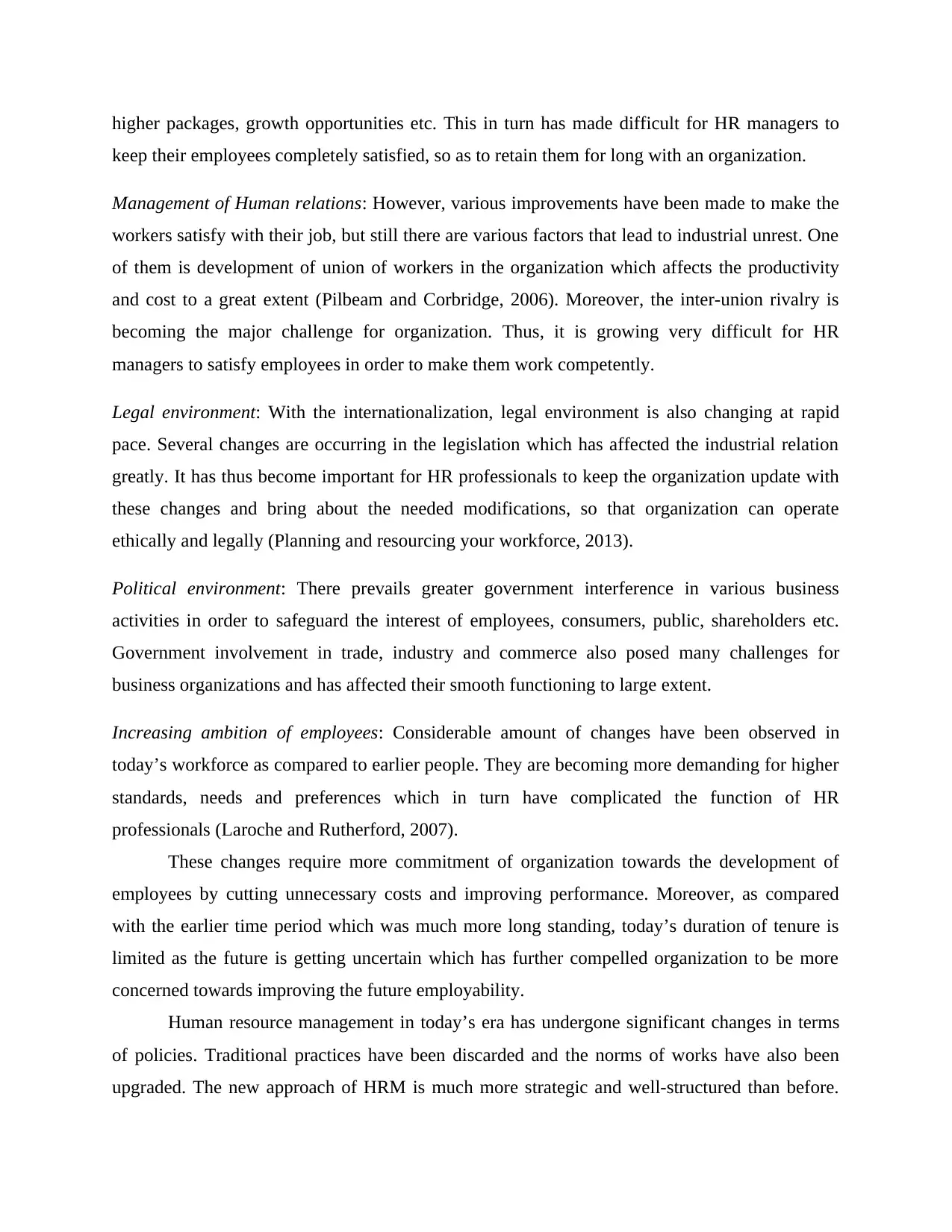
higher packages, growth opportunities etc. This in turn has made difficult for HR managers to
keep their employees completely satisfied, so as to retain them for long with an organization.
Management of Human relations: However, various improvements have been made to make the
workers satisfy with their job, but still there are various factors that lead to industrial unrest. One
of them is development of union of workers in the organization which affects the productivity
and cost to a great extent (Pilbeam and Corbridge, 2006). Moreover, the inter-union rivalry is
becoming the major challenge for organization. Thus, it is growing very difficult for HR
managers to satisfy employees in order to make them work competently.
Legal environment: With the internationalization, legal environment is also changing at rapid
pace. Several changes are occurring in the legislation which has affected the industrial relation
greatly. It has thus become important for HR professionals to keep the organization update with
these changes and bring about the needed modifications, so that organization can operate
ethically and legally (Planning and resourcing your workforce, 2013).
Political environment: There prevails greater government interference in various business
activities in order to safeguard the interest of employees, consumers, public, shareholders etc.
Government involvement in trade, industry and commerce also posed many challenges for
business organizations and has affected their smooth functioning to large extent.
Increasing ambition of employees: Considerable amount of changes have been observed in
today’s workforce as compared to earlier people. They are becoming more demanding for higher
standards, needs and preferences which in turn have complicated the function of HR
professionals (Laroche and Rutherford, 2007).
These changes require more commitment of organization towards the development of
employees by cutting unnecessary costs and improving performance. Moreover, as compared
with the earlier time period which was much more long standing, today’s duration of tenure is
limited as the future is getting uncertain which has further compelled organization to be more
concerned towards improving the future employability.
Human resource management in today’s era has undergone significant changes in terms
of policies. Traditional practices have been discarded and the norms of works have also been
upgraded. The new approach of HRM is much more strategic and well-structured than before.
keep their employees completely satisfied, so as to retain them for long with an organization.
Management of Human relations: However, various improvements have been made to make the
workers satisfy with their job, but still there are various factors that lead to industrial unrest. One
of them is development of union of workers in the organization which affects the productivity
and cost to a great extent (Pilbeam and Corbridge, 2006). Moreover, the inter-union rivalry is
becoming the major challenge for organization. Thus, it is growing very difficult for HR
managers to satisfy employees in order to make them work competently.
Legal environment: With the internationalization, legal environment is also changing at rapid
pace. Several changes are occurring in the legislation which has affected the industrial relation
greatly. It has thus become important for HR professionals to keep the organization update with
these changes and bring about the needed modifications, so that organization can operate
ethically and legally (Planning and resourcing your workforce, 2013).
Political environment: There prevails greater government interference in various business
activities in order to safeguard the interest of employees, consumers, public, shareholders etc.
Government involvement in trade, industry and commerce also posed many challenges for
business organizations and has affected their smooth functioning to large extent.
Increasing ambition of employees: Considerable amount of changes have been observed in
today’s workforce as compared to earlier people. They are becoming more demanding for higher
standards, needs and preferences which in turn have complicated the function of HR
professionals (Laroche and Rutherford, 2007).
These changes require more commitment of organization towards the development of
employees by cutting unnecessary costs and improving performance. Moreover, as compared
with the earlier time period which was much more long standing, today’s duration of tenure is
limited as the future is getting uncertain which has further compelled organization to be more
concerned towards improving the future employability.
Human resource management in today’s era has undergone significant changes in terms
of policies. Traditional practices have been discarded and the norms of works have also been
upgraded. The new approach of HRM is much more strategic and well-structured than before.
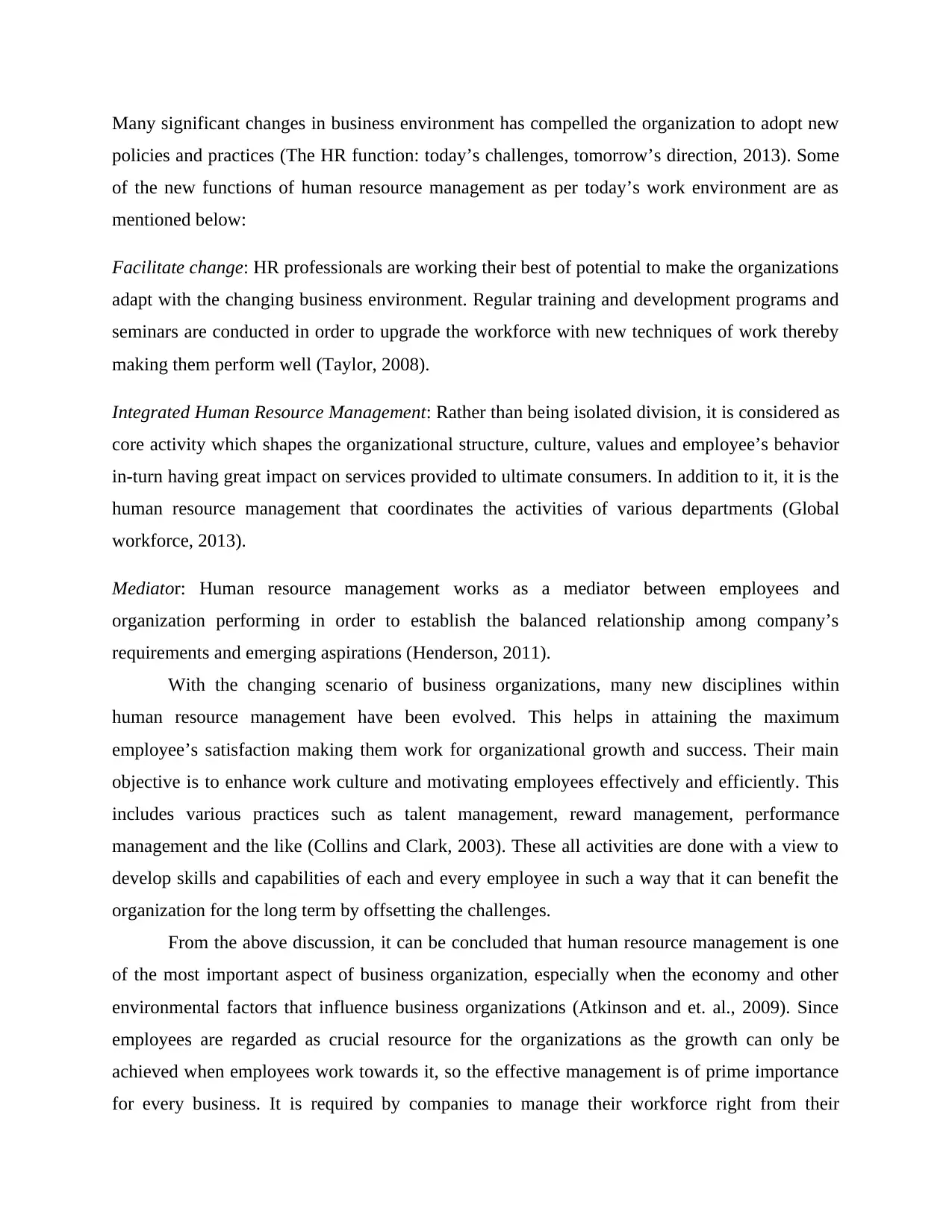
Many significant changes in business environment has compelled the organization to adopt new
policies and practices (The HR function: today’s challenges, tomorrow’s direction, 2013). Some
of the new functions of human resource management as per today’s work environment are as
mentioned below:
Facilitate change: HR professionals are working their best of potential to make the organizations
adapt with the changing business environment. Regular training and development programs and
seminars are conducted in order to upgrade the workforce with new techniques of work thereby
making them perform well (Taylor, 2008).
Integrated Human Resource Management: Rather than being isolated division, it is considered as
core activity which shapes the organizational structure, culture, values and employee’s behavior
in-turn having great impact on services provided to ultimate consumers. In addition to it, it is the
human resource management that coordinates the activities of various departments (Global
workforce, 2013).
Mediator: Human resource management works as a mediator between employees and
organization performing in order to establish the balanced relationship among company’s
requirements and emerging aspirations (Henderson, 2011).
With the changing scenario of business organizations, many new disciplines within
human resource management have been evolved. This helps in attaining the maximum
employee’s satisfaction making them work for organizational growth and success. Their main
objective is to enhance work culture and motivating employees effectively and efficiently. This
includes various practices such as talent management, reward management, performance
management and the like (Collins and Clark, 2003). These all activities are done with a view to
develop skills and capabilities of each and every employee in such a way that it can benefit the
organization for the long term by offsetting the challenges.
From the above discussion, it can be concluded that human resource management is one
of the most important aspect of business organization, especially when the economy and other
environmental factors that influence business organizations (Atkinson and et. al., 2009). Since
employees are regarded as crucial resource for the organizations as the growth can only be
achieved when employees work towards it, so the effective management is of prime importance
for every business. It is required by companies to manage their workforce right from their
policies and practices (The HR function: today’s challenges, tomorrow’s direction, 2013). Some
of the new functions of human resource management as per today’s work environment are as
mentioned below:
Facilitate change: HR professionals are working their best of potential to make the organizations
adapt with the changing business environment. Regular training and development programs and
seminars are conducted in order to upgrade the workforce with new techniques of work thereby
making them perform well (Taylor, 2008).
Integrated Human Resource Management: Rather than being isolated division, it is considered as
core activity which shapes the organizational structure, culture, values and employee’s behavior
in-turn having great impact on services provided to ultimate consumers. In addition to it, it is the
human resource management that coordinates the activities of various departments (Global
workforce, 2013).
Mediator: Human resource management works as a mediator between employees and
organization performing in order to establish the balanced relationship among company’s
requirements and emerging aspirations (Henderson, 2011).
With the changing scenario of business organizations, many new disciplines within
human resource management have been evolved. This helps in attaining the maximum
employee’s satisfaction making them work for organizational growth and success. Their main
objective is to enhance work culture and motivating employees effectively and efficiently. This
includes various practices such as talent management, reward management, performance
management and the like (Collins and Clark, 2003). These all activities are done with a view to
develop skills and capabilities of each and every employee in such a way that it can benefit the
organization for the long term by offsetting the challenges.
From the above discussion, it can be concluded that human resource management is one
of the most important aspect of business organization, especially when the economy and other
environmental factors that influence business organizations (Atkinson and et. al., 2009). Since
employees are regarded as crucial resource for the organizations as the growth can only be
achieved when employees work towards it, so the effective management is of prime importance
for every business. It is required by companies to manage their workforce right from their
⊘ This is a preview!⊘
Do you want full access?
Subscribe today to unlock all pages.

Trusted by 1+ million students worldwide
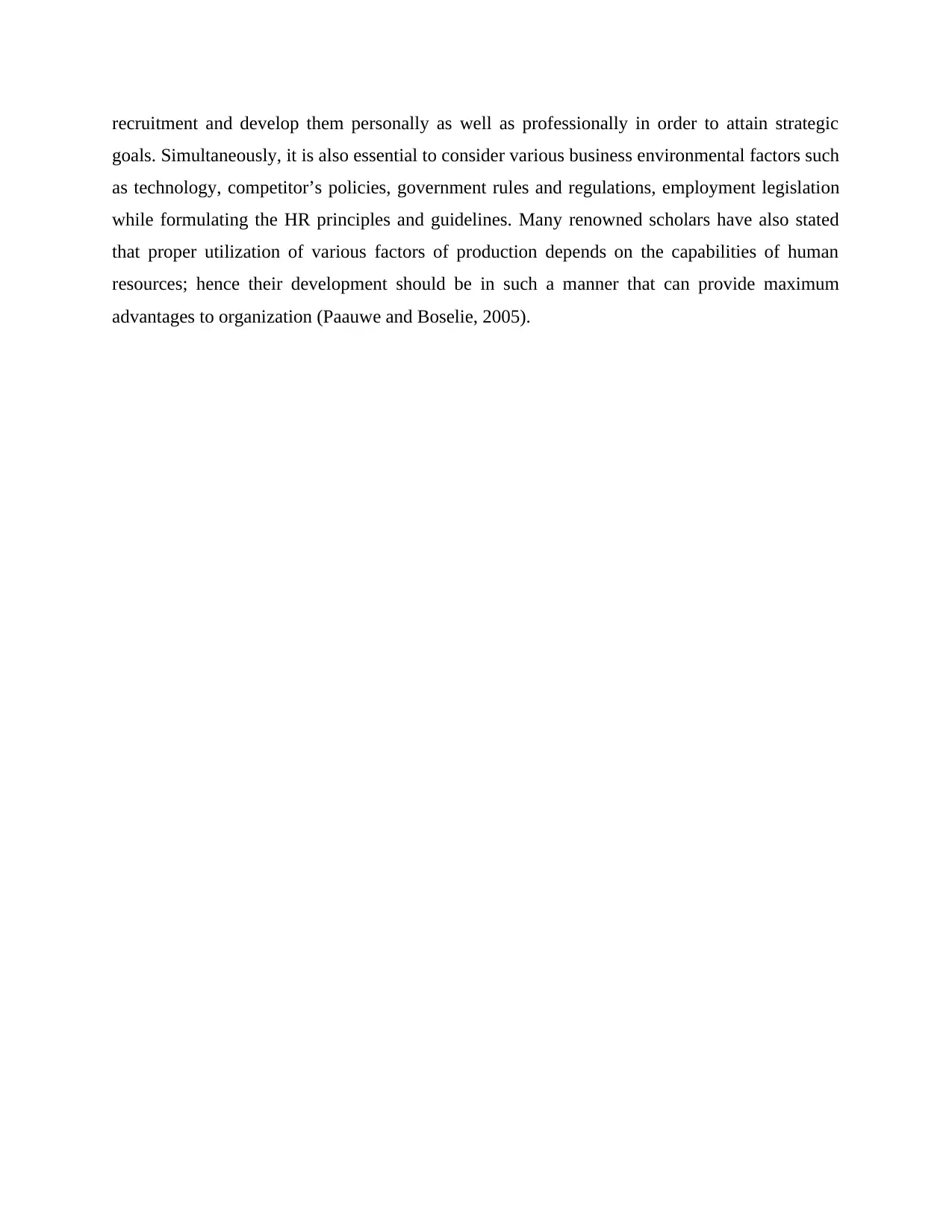
recruitment and develop them personally as well as professionally in order to attain strategic
goals. Simultaneously, it is also essential to consider various business environmental factors such
as technology, competitor’s policies, government rules and regulations, employment legislation
while formulating the HR principles and guidelines. Many renowned scholars have also stated
that proper utilization of various factors of production depends on the capabilities of human
resources; hence their development should be in such a manner that can provide maximum
advantages to organization (Paauwe and Boselie, 2005).
goals. Simultaneously, it is also essential to consider various business environmental factors such
as technology, competitor’s policies, government rules and regulations, employment legislation
while formulating the HR principles and guidelines. Many renowned scholars have also stated
that proper utilization of various factors of production depends on the capabilities of human
resources; hence their development should be in such a manner that can provide maximum
advantages to organization (Paauwe and Boselie, 2005).
Paraphrase This Document
Need a fresh take? Get an instant paraphrase of this document with our AI Paraphraser
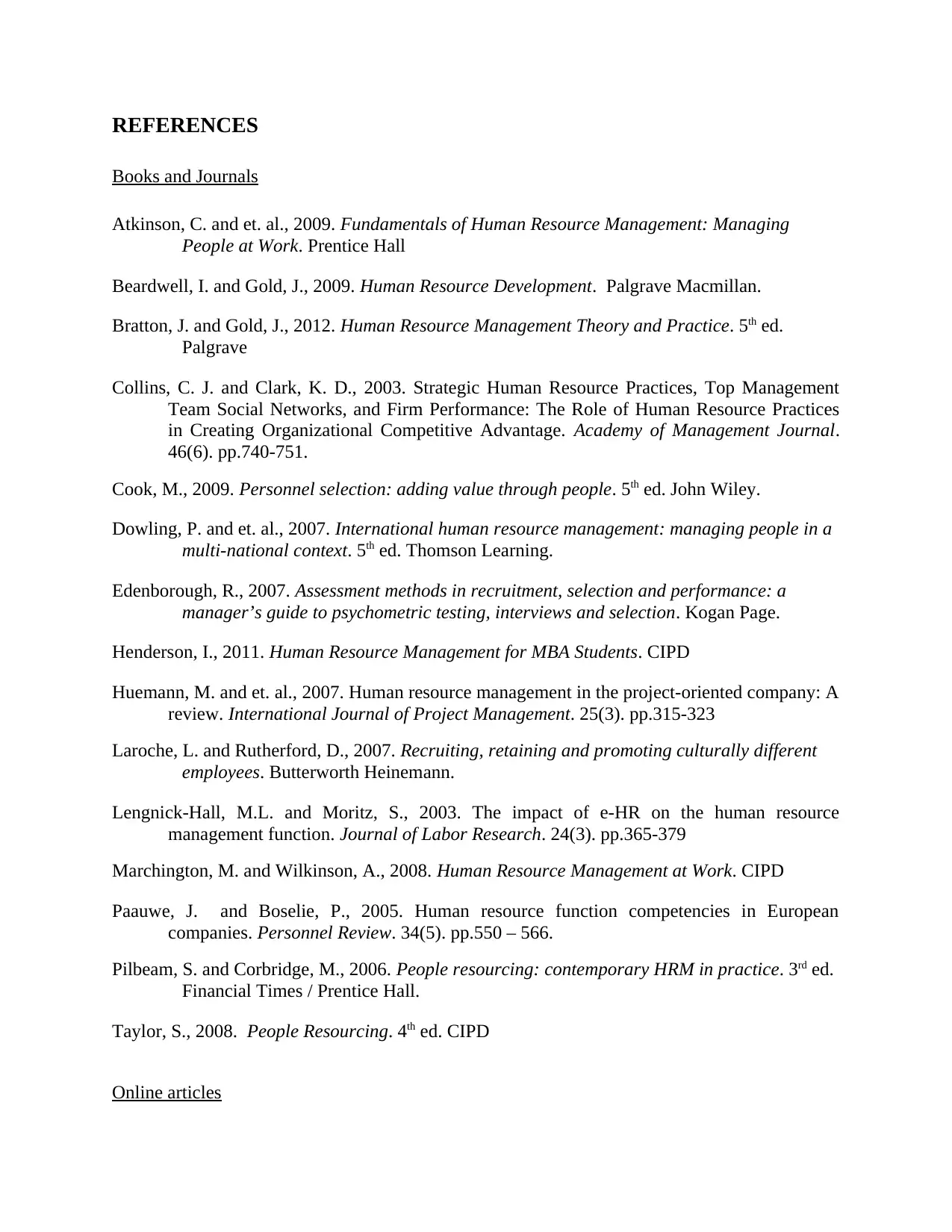
REFERENCES
Books and Journals
Atkinson, C. and et. al., 2009. Fundamentals of Human Resource Management: Managing
People at Work. Prentice Hall
Beardwell, I. and Gold, J., 2009. Human Resource Development. Palgrave Macmillan.
Bratton, J. and Gold, J., 2012. Human Resource Management Theory and Practice. 5th ed.
Palgrave
Collins, C. J. and Clark, K. D., 2003. Strategic Human Resource Practices, Top Management
Team Social Networks, and Firm Performance: The Role of Human Resource Practices
in Creating Organizational Competitive Advantage. Academy of Management Journal.
46(6). pp.740-751.
Cook, M., 2009. Personnel selection: adding value through people. 5th ed. John Wiley.
Dowling, P. and et. al., 2007. International human resource management: managing people in a
multi-national context. 5th ed. Thomson Learning.
Edenborough, R., 2007. Assessment methods in recruitment, selection and performance: a
manager’s guide to psychometric testing, interviews and selection. Kogan Page.
Henderson, I., 2011. Human Resource Management for MBA Students. CIPD
Huemann, M. and et. al., 2007. Human resource management in the project-oriented company: A
review. International Journal of Project Management. 25(3). pp.315-323
Laroche, L. and Rutherford, D., 2007. Recruiting, retaining and promoting culturally different
employees. Butterworth Heinemann.
Lengnick-Hall, M.L. and Moritz, S., 2003. The impact of e-HR on the human resource
management function. Journal of Labor Research. 24(3). pp.365-379
Marchington, M. and Wilkinson, A., 2008. Human Resource Management at Work. CIPD
Paauwe, J. and Boselie, P., 2005. Human resource function competencies in European
companies. Personnel Review. 34(5). pp.550 – 566.
Pilbeam, S. and Corbridge, M., 2006. People resourcing: contemporary HRM in practice. 3rd ed.
Financial Times / Prentice Hall.
Taylor, S., 2008. People Resourcing. 4th ed. CIPD
Online articles
Books and Journals
Atkinson, C. and et. al., 2009. Fundamentals of Human Resource Management: Managing
People at Work. Prentice Hall
Beardwell, I. and Gold, J., 2009. Human Resource Development. Palgrave Macmillan.
Bratton, J. and Gold, J., 2012. Human Resource Management Theory and Practice. 5th ed.
Palgrave
Collins, C. J. and Clark, K. D., 2003. Strategic Human Resource Practices, Top Management
Team Social Networks, and Firm Performance: The Role of Human Resource Practices
in Creating Organizational Competitive Advantage. Academy of Management Journal.
46(6). pp.740-751.
Cook, M., 2009. Personnel selection: adding value through people. 5th ed. John Wiley.
Dowling, P. and et. al., 2007. International human resource management: managing people in a
multi-national context. 5th ed. Thomson Learning.
Edenborough, R., 2007. Assessment methods in recruitment, selection and performance: a
manager’s guide to psychometric testing, interviews and selection. Kogan Page.
Henderson, I., 2011. Human Resource Management for MBA Students. CIPD
Huemann, M. and et. al., 2007. Human resource management in the project-oriented company: A
review. International Journal of Project Management. 25(3). pp.315-323
Laroche, L. and Rutherford, D., 2007. Recruiting, retaining and promoting culturally different
employees. Butterworth Heinemann.
Lengnick-Hall, M.L. and Moritz, S., 2003. The impact of e-HR on the human resource
management function. Journal of Labor Research. 24(3). pp.365-379
Marchington, M. and Wilkinson, A., 2008. Human Resource Management at Work. CIPD
Paauwe, J. and Boselie, P., 2005. Human resource function competencies in European
companies. Personnel Review. 34(5). pp.550 – 566.
Pilbeam, S. and Corbridge, M., 2006. People resourcing: contemporary HRM in practice. 3rd ed.
Financial Times / Prentice Hall.
Taylor, S., 2008. People Resourcing. 4th ed. CIPD
Online articles
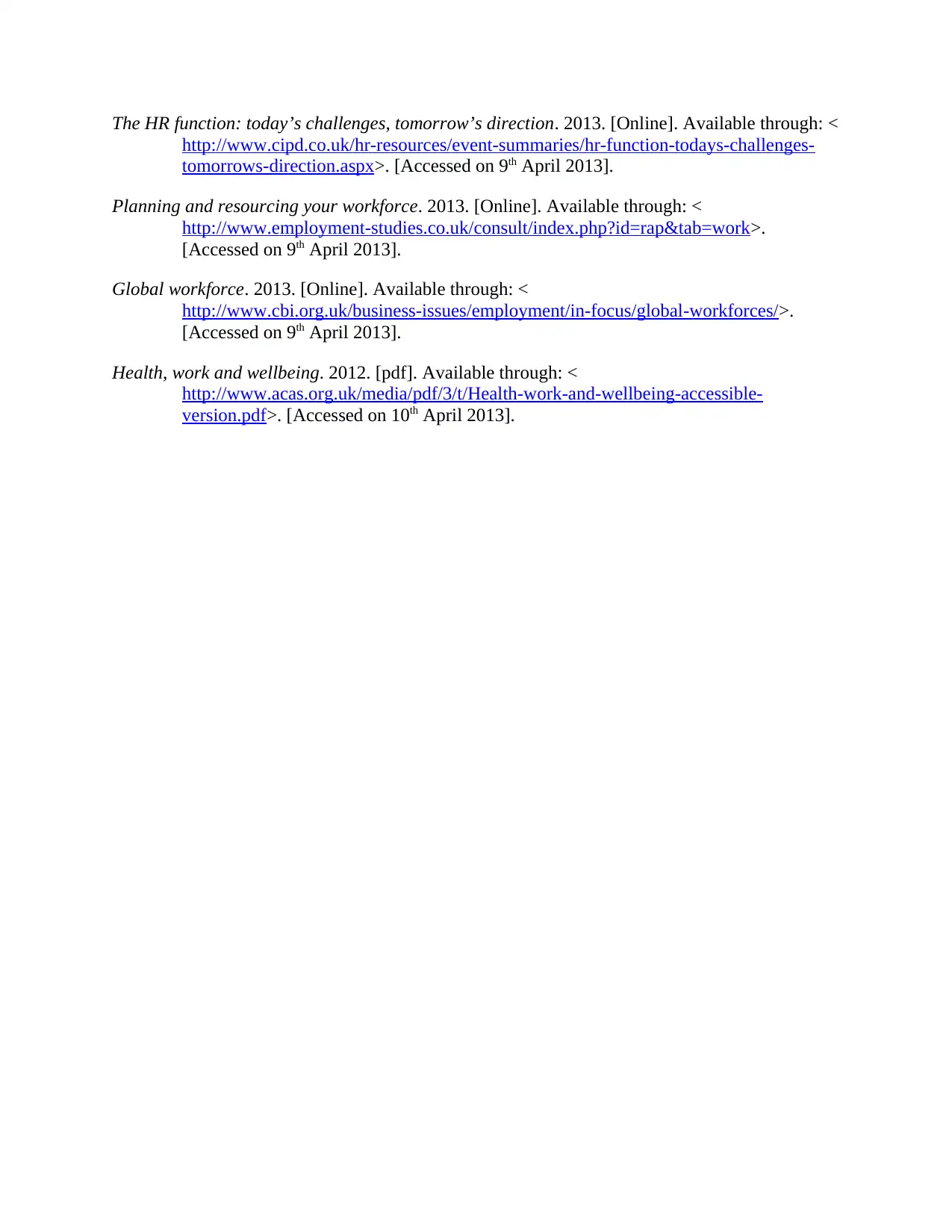
The HR function: today’s challenges, tomorrow’s direction. 2013. [Online]. Available through: <
http://www.cipd.co.uk/hr-resources/event-summaries/hr-function-todays-challenges-
tomorrows-direction.aspx>. [Accessed on 9th April 2013].
Planning and resourcing your workforce. 2013. [Online]. Available through: <
http://www.employment-studies.co.uk/consult/index.php?id=rap&tab=work>.
[Accessed on 9th April 2013].
Global workforce. 2013. [Online]. Available through: <
http://www.cbi.org.uk/business-issues/employment/in-focus/global-workforces/>.
[Accessed on 9th April 2013].
Health, work and wellbeing. 2012. [pdf]. Available through: <
http://www.acas.org.uk/media/pdf/3/t/Health-work-and-wellbeing-accessible-
version.pdf>. [Accessed on 10th April 2013].
http://www.cipd.co.uk/hr-resources/event-summaries/hr-function-todays-challenges-
tomorrows-direction.aspx>. [Accessed on 9th April 2013].
Planning and resourcing your workforce. 2013. [Online]. Available through: <
http://www.employment-studies.co.uk/consult/index.php?id=rap&tab=work>.
[Accessed on 9th April 2013].
Global workforce. 2013. [Online]. Available through: <
http://www.cbi.org.uk/business-issues/employment/in-focus/global-workforces/>.
[Accessed on 9th April 2013].
Health, work and wellbeing. 2012. [pdf]. Available through: <
http://www.acas.org.uk/media/pdf/3/t/Health-work-and-wellbeing-accessible-
version.pdf>. [Accessed on 10th April 2013].
⊘ This is a preview!⊘
Do you want full access?
Subscribe today to unlock all pages.

Trusted by 1+ million students worldwide
1 out of 9
Related Documents
Your All-in-One AI-Powered Toolkit for Academic Success.
+13062052269
info@desklib.com
Available 24*7 on WhatsApp / Email
![[object Object]](/_next/static/media/star-bottom.7253800d.svg)
Unlock your academic potential
Copyright © 2020–2025 A2Z Services. All Rights Reserved. Developed and managed by ZUCOL.





